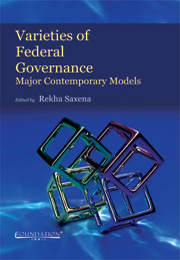Book contents
- Frontmatter
- Contents
- List of Contributors
- Foreword
- Acknowledgements
- Introduction
- I Theoretical and Comparative Dimensions
- II Presidential Federal Systems
- 3 Political Coercion and Administrative Cooperation in U.S. Intergovernmental Relations
- 4 What Makes the Swiss Multicultural Federalism Work
- 5 Local Governments in the Brazilian Federation
- 6 Russian Federalism: Does it Work?
- 7 Federalism in Pakistan
- III Commonwealth Parliamentary Federations
- IV Non-Commonwealth Parliamentary Federations in Afro-Asia
- V European Parliamentary Federations
- VI Devolutionary Systems
- VII Supranational Confederalism/Federalism?
3 - Political Coercion and Administrative Cooperation in U.S. Intergovernmental Relations
from II - Presidential Federal Systems
Published online by Cambridge University Press: 05 June 2012
- Frontmatter
- Contents
- List of Contributors
- Foreword
- Acknowledgements
- Introduction
- I Theoretical and Comparative Dimensions
- II Presidential Federal Systems
- 3 Political Coercion and Administrative Cooperation in U.S. Intergovernmental Relations
- 4 What Makes the Swiss Multicultural Federalism Work
- 5 Local Governments in the Brazilian Federation
- 6 Russian Federalism: Does it Work?
- 7 Federalism in Pakistan
- III Commonwealth Parliamentary Federations
- IV Non-Commonwealth Parliamentary Federations in Afro-Asia
- V European Parliamentary Federations
- VI Devolutionary Systems
- VII Supranational Confederalism/Federalism?
Summary
Contemporary American federalism can be described as an era of coercive or regulatory federalism in which the predominant political, fiscal, statutory, regulatory, and judicial trends have entailed impositions of federal dictates on state and local governments. This era began in the late 1960s and succeeded a 35-year era commonly referred to as cooperative federalism. The era of coercive federalism has been marked by a shift of federal policy-making from the interests of places (i.e., state and local governments) to the interests of persons (i.e., voters and interest groups). That is, elected federal officials, as well as the federal courts, have been highly responsive to electoral coalitions, interest groups, and campaign contributors operating in the national arena and much less responsive to elected state and local government officials. Elected state and local officials no longer have any privileged voice in Congress or the White House as elected representatives of the people; instead, they must behave like interest groups and compete with all other interest groups in the federal policymaking arena where, quite frequently, they are unable to prevail against powerful interest groups that can bring crucial financial, ideological, and voter rewards and punishments to bear on the electoral fortunes of federal officials. Consequently, as U.S. Senator Carl Levin (Democrat-Michigan) commented to this author in 1988, ‘There is no political capital [for members of Congress] in intergovernmental relations,’ that is, in catering to the concerns of governors, state legislators, county commissioners, mayors, and the like.
- Type
- Chapter
- Information
- Varieties of Federal GovernanceMajor Contemporary Models, pp. 37 - 53Publisher: Foundation BooksPrint publication year: 2011
- 3
- Cited by

